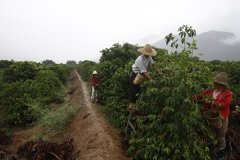Differences in flavor between Sri Lankan Ceylon, Darjeeling and Yunnan Hongying Hongzhengshan black tea
Flavor of black tea producing area
Dianhong Yinghong has many big leaf species, Qimen middle leaf species, flower aroma, aroma typical No. 9 in Yingde is sucrose fragrance and potato fragrance. In recent years, few people say that sweet potato is fragrant.
Sri Lanka, formerly known as Ceylon
"Sri Lankan black tea" and "Ceylon black tea" refer to the same thing.
In 1658, the Dutch grew coffee in Ceylon (present-day Sri Lanka), but the coffee was sufficient for economic development until the 19th century.
At this time, Britain occupied Ceylon and carried out experimental cultivation of various cash crops, which was another outstanding achievement on the island after the success of trial planting in Jamaica.
In 1827, when the abolition of slavery in western India led to a decline in coffee production, Ceylon Coffee duly filled the gap and gained a place in the coffee market.
From 1830 to 1850, the coffee industry dominated Ceylon.
In 1841, the Bank of Ceylon was established to facilitate the use of funds for the coffee industry.
In addition, in order to transport coffee, the road and railway network was also established at this time, and the government system almost became a vassal of the coffee industry.
In 1846, with the recession of the world economy and the low price of coffee, Ceylon's finance collapsed and unrest broke out. From then on, the colonial government decided to turn the original agricultural land into cultivation, such as coconut, cocoa and rubber.
Conflicts often break out in the process of transformation. On the other hand, the grain arable land decreased sharply, and the food shortage broke out at the end of the 19th century.
In 1869, a devastating rust leaf disease broke out in Ceylon. Over the past 15 years, the disease has almost destroyed the coffee industry in Ceylon, and the country is busy looking for alternative industries.
Later, tea trees were introduced from China and India. Tea production began to replace coffee cultivation, and tea has gradually replaced coffee and become the most important export material so far.
Today, only a small amount of coffee is produced in Sri Lanka, with an annual output of about 2,000 tons. Robusta species account for the majority, and coffee beans are mainly sold domestically.
Important Notice :
前街咖啡 FrontStreet Coffee has moved to new addredd:
FrontStreet Coffee Address: 315,Donghua East Road,GuangZhou
Tel:020 38364473
- Prev

The price of caffeine tea in Yunnan, China collapses, "Black Gold" soars, Pu'er Town changes to Coffee
Professional baristas follow Coffee Workshop (Wechat official account cafe_style) Pu'er Town, a city on the border between Yunnan and Myanmar, many families have grown Pu'er tea in this continuous hilly area for the past 2000 years. Pu'er tea is famous for its simple flavor. Tea lovers say that the taste of Pu'er tea becomes more mellow with the increase of tea age. However, its price
- Next

China's coffee growing industry may encounter "price winter" appeal to the public to drink more "Yunnan coffee beans"!
Professional barista exchanges, please pay attention to coffee workshop (Weixin Official Accounts cafe_style) China's largest coffee producing area Yunnan Province is about to usher in the harvest season. The industry expects that China's coffee planting industry will encounter "price winter" again in the new season, and the industry appeals to the public to drink more Yunnan coffee beans to help coffee growers and enterprises survive the winter. Yunnan Province Coffee Industry Association recently released
Related
- Detailed explanation of Jadeite planting Land in Panamanian Jadeite Manor introduction to the grading system of Jadeite competitive bidding, Red bid, Green bid and Rose Summer
- Story of Coffee planting in Brenka region of Costa Rica Stonehenge Manor anaerobic heavy honey treatment of flavor mouth
- What's on the barrel of Blue Mountain Coffee beans?
- Can American coffee also pull flowers? How to use hot American style to pull out a good-looking pattern?
- Can you make a cold extract with coffee beans? What is the right proportion for cold-extracted coffee formula?
- Indonesian PWN Gold Mandrine Coffee Origin Features Flavor How to Chong? Mandolin coffee is American.
- A brief introduction to the flavor characteristics of Brazilian yellow bourbon coffee beans
- What is the effect of different water quality on the flavor of cold-extracted coffee? What kind of water is best for brewing coffee?
- Why do you think of Rose Summer whenever you mention Panamanian coffee?
- Introduction to the characteristics of authentic blue mountain coffee bean producing areas? What is the CIB Coffee Authority in Jamaica?

